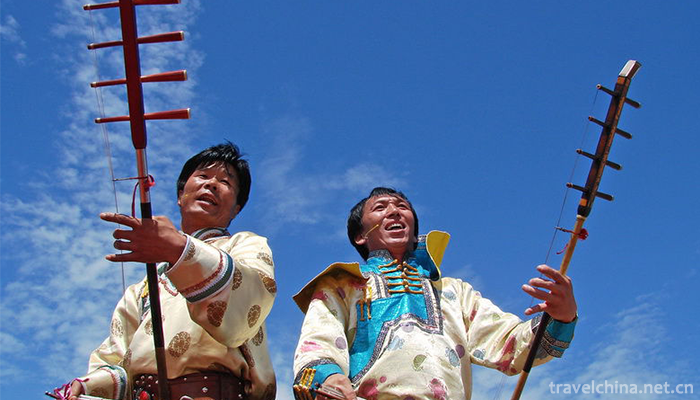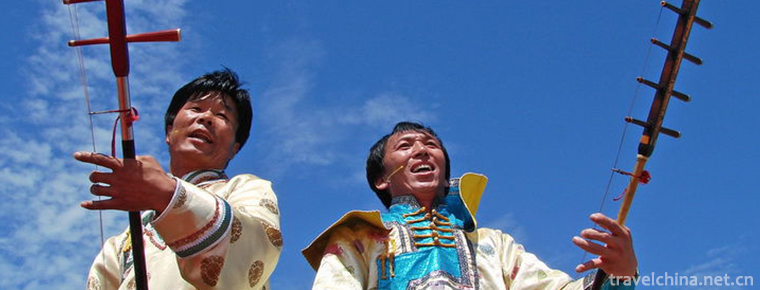Good luck treasure
Good luck treasure
Haolaibao is a kind of Chinese Mongolian folk music, singing in Mongolian. Haolaibao means "alliteration" in Mongolian, that is, the first syllabic rhyme of each line of lyrics, so it is also called alliteration. Others translate Haolaibao as "singing in tandem" or "singing in tandem".
On June 7, 2008, Haolaibao was listed in the second batch of national intangible cultural heritage list with the approval of the State Council.
brief introduction
Mongolian koji. It means "sing in tandem" or "sing in tandem". The performance features are similar to those of the Han nationality in Nulaibao and Lianhua Falls.
Haolaibao is also called "Haolibao". Mongolian transliteration is one of Mongolian folk arts. It is a kind of folk art form in which one or more people perform "rap and singing" in Mongolian language accompanied by four HUS and other musical instruments. It was formed around the 12th century A.D. It is sung in Mongolian, with a fixed tune and a certain rhythm. At first, the lyrics were sung improvisely, then they began to create, and a large number of "Haolaibao" writers appeared. Mao Yihan, Pajie and Salazi are folk artists deeply loved by the Mongolian people. The forms of singing are also varied, with two people singing, one person asking and answering questions and many people singing. When singing, each actor plays a horse-head piano or four-hu, sings by himself and performs while singing. The lyrics are four sentences and one section, alliteration. Or four sentences one rhyme, or two sentences one rhyme, there are dozens of lyrics one rhyme to the end of the situation. The length of performances can be long or short, and artists often improvise on-the-spot compilation and singing. The content of the program can be narrative, lyric, praise and satire. Rhetorical devices, including metaphor, exaggeration, parallelism and repetition, are widely used. So that its performance has the characteristics of wit, humor, lively rhythm, and sound and incisive. In addition to the general amorous feelings of children, changes in the world and intellectual content, there are also many folk stories and adapted classical chapters and chapters of fiction. After the founding of New China, many works reflecting the socialist construction have been produced, such as "Iron Niu" by Mao Yihan, an artist. Haolaibao's music is changeable, lively and lively, simple and graceful in lyrics and moving in language. Singing in Mongolian, the performers are all male, accompanied by four hus. There are three ways of expression: singing with one mouth, singing with one voice, singing with one voice; singing with two voices; singing with two voices; singing with two voices; and singing with group voices. It is a kind of musical form created by Wulan horseman in the 1960s according to the singing characteristics of the traditional Haolaibao. It is performed by four to six people, singing in unison, leading singing and singing in pairs. Most of its themes focus on eulogizing the socialist motherland.
History
There are different opinions on the origin of Haolaibao, which is generally believed to be derived from "Uruguay". The earliest Haolaibao is a part of Uruguay, such as hero's ode, homesickness praise horse, landscape close-up, general's battle, two armies'battle, army march, Dynasty play book, love between men and women, all can become a vivid interlude in the storytelling. The earliest album "Princess Yandan" is a lyric that praises Princess Yandan when the artist tells the story of the Seven Kingdoms. It depicts the beautiful and talented Princess Miaoling vividly and vividly, which has been handed down to the present day. In the nearly 200 years of singing practice, many artists with innovative genius have constantly broken some old conventions, compiled tunes according to their content, and adopted more techniques such as exaggeration, contrast and elaboration, in witty and funny language, rhyming poems, describing the people and things familiar to the singer, giving people artistic enjoyment and making them better. Laibao has gradually become an independent form of folk art.
Since the beginning of the 20th century, the performances of Haolaibao have been diversified. In addition to the performances such as Princess Yandan, Rich Chagan Lake and Being an Artist, the historical stories of the Han nationality such as Wang Zhaojun's Story, Water Margin and Romance of the Three Kingdoms have also been compiled by Haolaibao artists.
After the founding of the People's Republic of China, the ideological content and artistic level of Helibao have improved, and some excellent performers such as Pajie and Mao Yihan have emerged. Over the years, many literary and artistic workers have constantly reformed this popular art form. We have transformed single Haolaibao into multi-person Haolaibao. We have boldly tried all kinds of musical instruments accompaniment, added drama plot and dance movements, and performed with solo, duet, rotation and chorus, giving full play to the artistic charm of Haolaibao.
In the mid-1960s, professional literary and artistic groups such as Ulan Muqi made bold reforms on the performance form of Helebao, changing the form of self-singing of an actor to that of holding a four-hu singing for several actors, accompanied by various musical instruments such as yangqin, three strings, flute and drum. Several people, you and I are singing together, or several people are playing together, singing a song together, so that solo, duet, rotation, chorus and other alternative use, so that poetry, narrative, singing, dancing, etc. into one, so that the audience can refresh, known as "Nailihao Laibao" or "Symphony Laibao". Later, amateur propaganda teams learned to sing and perform one after another, making it spread rapidly in Inner Mongolia.


-
1.Water surface
The water surface is a traditional snack in Shaanxi and Gansu Province. Legend has it that Liu Bang, the ancestor of the Han Dynasty
Time 2018-11-02 -
2.Lushan Karst Cave Group Scenic Area
Yiyuan Karst Cave Group is located in Nanlushan Town, 7 kilometers northwest of Yiyuan County. It has been proved that there are more than 100 caves in the area of 5 square kilometers around the ape-m
Time 2019-02-06 -
3.Songxian Tianchishan National Forest Park
The Tianchishan National Forest Park in Songxian County, Luoyang City, is located in Xionger Mountains, northwest of Songxian County, Luoyang City, with a total area of 1716 hectares and a forest cove
Time 2019-02-13 -
4.Silver Cave
Yinzi karst cave is a typical karst landform, which runs through 12 peaks and belongs to floor-type karst cave. The cave contains stalactites developed in different geological ages
Time 2019-03-04 -
5.Ningbo Gold and Silver Embroidery
Ningbo gold and silver embroidery is one of the Han folk handicraft products embroidered on silk fabrics with various color threads, gold threads and silver threads. With its strong local characterist
Time 2019-06-07 -
6.Daoism in Northern Shaanxi
As one of the traditional folk songs in northern Shaanxi, Daoqing in northern Shaanxi was originally called "Qingjian Daoqing". Later, because "Longdong Daoqing" and "Shenchi
Time 2019-06-13 -
7.Capital Institute of Physical Education
Capital Institute of Physical Education is a sports class in Beijing. Ordinary universities Located on Beijing City Haidian District, West Zhongguancun Science Park District, east of Yan Mu scenic are
Time 2019-11-24 -
8.Geographical environment of Deyang
Deyang City is located in the northeast edge of Chengdu Plain, with geographical coordinates of 30 ° 31 ′ - 31 ° 42 ′ N and 103 ° 45 ′ - 105 ° 15 ′ E. Deyang borders Fucheng District of Mianyang City in the northeast, Santai County of Mianyang City in the East
Time 2020-12-14 -
9.Deyang Education
By the end of 2018, Deyang had 856 schools, with 33000 full-time teachers and 543000 students. Among them, 339 primary schools enroll 32000 students and 185000 students; 123 junior high schools, 28000 students and 80000 students; 23 senior high schools
Time 2020-12-14 -
10.Environmental protection in Mianyang
In 2018, the water quality of Fujiang, Kaijiang, Zijiang, Anchang River, Furong River, Tongkou River and Luban reservoir in Mianyang City accounted for 100% of the total water quality. Among them, Fujiang River, Tongkou River, Zijiang River and Anchang
Time 2020-12-14 -
11.Mineral resources in Leshan
Leshan City is rich in mineral resources, 34 kinds of mineral resources have been proved, especially non-metallic minerals, with great development potential. Among them, the total amount of proven rock salt resources is 10.5 billion tons, with an annual
Time 2020-12-17 -
12.Plant resources in Meishan
There are 2278 species of wild plants belonging to 861 genera and 229 families in Meishan City, including 149 species of bryophytes belonging to 71 genera and 48 families, 155 species of ferns belonging to 73 genera and 36 families, 20 species of gymnosperms
Time 2020-12-18